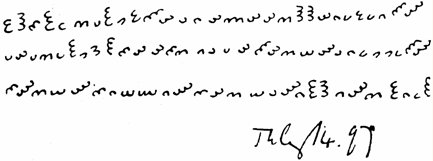In 1897, the composer Edward Elgar sent a short (and apparently enciphered) note to a young lady-friend Dora Penny – because his later nickname for her was “Dorabella”, this note has acquired the name “The Dorabella Cipher“. Though short, its connection to a famous composer coupled with its inability to be deciphered has led to an enduring level of interest.
Elgar was fascinated by secret writing, even cracking a supposedly ‘uncrackable’ cipher published in Pall Mall Magazine: and part of his fame arises from the way he concealed identities of various friends (as well as a well-known melody in counterpoint) in his famous Enigma Variations (which the German Enigma machine was named after, in homage to Elgar). Musicologists have managed to decrypt most of the secrets of the Enigma Variation: but what of this short note?
The letter-shapes are formed from a simple 24-letter symmetrical key (a pigpen cipher variant using 3 versions each of 8 rotated E-shapes, likely a visual pun on Edward Elgar’s ‘EE’ initials). Intriguingly, this same cipher alphabet appears in two other places in Elgar’s notes.
Firstly, as a simple cipher:
The problem is that applying this (apparently correct) key to the Dorabella Cipher produces an apparently nonsensical cleartext:-
BLTACEIARWUNISNFNNELLHSYWYDUO INIEYARQATNNTEDMINUNEHOMSYRRYUO TOEHO’TSHGDOTNEHMOSALDOEADYA
The other place Elgar is known to have employed this alphabet is in the left margin of a Liszt concert programmer
Rotated round and a little closer, you can see the sequence more clearly:-
However, this arguably more closely resembles an idiosyncratic style of musical note-taking (because the number of elements matches the number of notes in the musical passage beside it) than a ciphertext as such, suggesting that the Dorabella Cipher might in fact be a melody. Even so, this Liszt fragment of apparently musical marginalia has not yet been decrypted, so it is arguably a little early to argue for anything more than superficial similarities here either.
The mystery of the Dorabella Cipher, then, is neither a whodunnit (because Elgar signed and even dated it), nor even a howdunnit (because it seems that we would already have the key to the cipher, if it were a cipher), but more like a “whodunnwhat” – we still don’t know what it is, or even how to try to read it.



